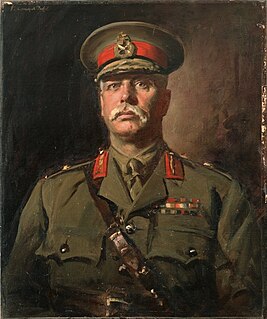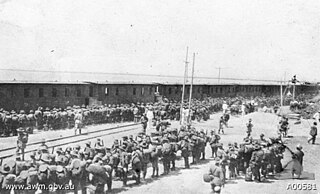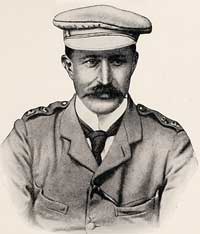
James Rogers, VC was an Australian recipient of the Victoria Cross, the highest award for gallantry in the face of the enemy that can be awarded to British and Commonwealth forces. Rogers received his award for his actions at Thaba 'Nchu in Orange Free State on 15 June 1901 while serving in the South African Constabulary during the Second Boer War.

Major General Sir Neville Reginald Howse, was an Australian Army officer, medical doctor, and politician. He was the first Australian recipient of the Victoria Cross (VC), the highest decoration for gallantry "in the face of the enemy" that can be awarded to members of the British and Commonwealth armed forces.

The Natal Carbineers Regiment is an infantry unit of the South African Army. As a reserve unit, it has a status roughly equivalent to that of a British Army Reserve or United States Army National Guard unit.

The Johannesburg Light Horse Regiment (JLHR), formerly the Light Horse Regiment (LHR) and Imperial Light Horse (ILH), is an armoured car reconnaissance unit of the South African Army. As a reserve unit, it has a status roughly equivalent to that of a British Army Reserve or United States Army National Guard unit. It is part of the South African Army Armour Formation and is based at Mount Collins in Sandton, Johannesburg.

Major General Charles Frederick Cox, was an Australian Army officer and politician. He retired in 1923 as an honorary major general.

The 1st Battalion was an infantry battalion of the Australian Army. Although its numerical name was designated during the First World War, the 1st Battalion can trace its lineage back to 1854, when a unit of the Volunteer Rifles was raised in Sydney, New South Wales. This unit has since been redesignated a number of times, but through its links with the units of the colonial NSW defence force, the battalion's history includes services in Sudan and South Africa. During the First World War, the 1st Battalion was raised for overseas service in 1914 as part of the First Australian Imperial Force. Attached to the 1st Brigade, the battalion served in Egypt initially before taking part in the fighting in Gallipoli against the Turks. Later the battalion was sent to the Western Front where it fought in the trenches in France and Belgium as part of the Australian Corps. Following the end of the war the battalion was disbanded in 1919.

The 17th Battalion was an infantry battalion of the Australian Army. Although its numerical designation was bestowed upon it during World War I, the 17th Battalion can trace its lineage back to 1860, when a unit of the New South Wales Volunteer Rifles was raised in St Leonards, New South Wales. This unit has since been disbanded and reformed a number times. Through its links with the units of the colonial New South Wales defence force, the battalion's history includes service in the Sudan and South Africa. During World War I, the 17th Battalion was raised for overseas service as part of the Australian Imperial Force. Attached to the 5th Brigade, 2nd Division, the battalion was raised in 1915 and sent to Egypt initially, before taking part in the fighting at Gallipoli against the Turks. Later the battalion was sent to the Western Front in France and Belgium, where it served in the trenches as part of the Australian Corps. Throughout the course of the war, the battalion won numerous battle honours and its members received many individual awards, however, at the end of the war the battalion was disbanded in April 1919.

The Battle of Diamond Hill (Donkerhoek) was an engagement of the Second Boer War that took place on 11 and 12 June 1900 in central Transvaal.

The 1st Royal New South Wales Lancers was an Australian Army light cavalry (reconnaissance) regiment. Its complicated lineage includes the New South Wales Lancers which were first formed as a colonial unit in 1885 as the New South Wales Cavalry, and subsequently saw action in the Second Boer War, and later during First World War at Gallipoli and Palestine as the 1st Light Horse Regiment. The unit subsequently served during the Second World War as the 1st Armoured Regiment equipped with Matilda tanks, fighting the Japanese in New Guinea and Borneo.

Major-General Sir Henry Jenner "Harry" Scobell, KCVO, CB was a British military leader who served as the last officer in command of Cape Colony before the formation of the Union of South Africa.

The military history of Australia during the Boer War is complex, and includes a period of history in which the six formerly autonomous British Australian colonies federated to become the Commonwealth of Australia. At the outbreak of the Second Boer War, each of these separate colonies maintained their own, independent military forces, but by the cessation of hostilities, these six armies had come under a centralised command to form the Australian Army.
Major-General Sir Gerald Farrell Boyd KCB, CMG, DSO, DCM was a senior British Army officer who went on to be Military Secretary.

The 10th Light Horse Regiment is a "light cavalry" regiment of the Australian Army Reserve, raised in Western Australia (WA).

The New South Wales Imperial Bushmen was a mounted regiment, consisting of six rifle squadrons, raised in the New South Wales colony for service during the Second Boer War.

Brigadier General John Robinson Royston, was a South African-born military officer who commanded a brigade of Australian Light Horse during the First World War.
The New South Wales Mounted Rifles was a mounted infantry regiment of the Colony of New South Wales.
The Queensland Citizen Bushmen, also known as the 3rd Queensland Mounted Infantry, was a mounted infantry regiment raised in Queensland for service during the Second Boer War. Formed as part of the third Queensland contingent with an original strength of 316 men, it departed for South Africa on 2 March 1900 aboard the Duke of Portland. Under the command of Major Walter Tunbridge, it initially served in Rhodesia, and later in west Transvaal, where it took part in the Relief of Mafeking, and actions at Koster River and Elands River. It then served in northern Transvaal, including actions at Rhenoster Kop and Wolwekuil, and the advance on Pietersburg. Fatal casualties included three men killed or died of wounds, and five dead from disease. The unit returned to Australia in June 1901 on the Morayshire.

The South Australian Mounted Rifles (SAMR) was a mounted infantry unit of the Colony of South Australia that served in the Second Boer War. The first contingent of South Australian Mounted Rifles was raised in 1899, followed by a second contingent in 1900.
The South Australian Bushmen was a mounted infantry squadron of the Colony of South Australia that served in the Second Boer War, the third contingent contributed by the colony.
The Australian Regiment was a regiment of troops from the Australian colonies that served in the Second Boer War. It began its existence as infantry but was soon mounted due to the conditions of the war.













